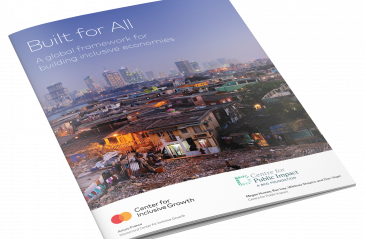
Systemic funding architecture: A proposition to catalyze urban climate finance

Governments are increasingly contracting with providers, paying only when outcomes are achieved
Share articleSocial Impact Bonds can ower costs without government taking on a substantial risk of failure
Share articleSocial Impact Bonds can deliver better management information an more flexibility to adapt
Share articleWe put our vision for government into practice through learning partner projects that align with our values and help reimagine government so that it works for everyone.
How can governments get better outcomes for citizens when public money is scarce?
That challenge is a major driving force for public service reform around the world. It has concentrated minds in areas of social policy where a better outcome for citizens is linked to a reduced demand for costly government services. That includes areas such as criminal justice, employment, health, and children's and adults' social care.
For example, the cost of putting someone in jail in the US has been estimated at between $19,000 and $26,000 for each year they spend inside. At the same time, the reoffending rate for adults after a jail sentence is over 50%. A service that could reduce reoffending by even a small amount would probably more than pay for itself, while also reducing crime and helping ex-offenders back on their feet.
But for political leaders and officials, every proposal that crosses their desks promises vast benefits in an uncertain tomorrow together with definite costs that have to be paid today. This presents leaders with three key problems:
1. How can they find the money to pay for effective services up front when savings will only materialise in the future?
2. How can they have greater confidence that the promised savings will be achieved - and that these savings will be seen by the budget-holder paying for the service, rather than other, far-flung parts of government?
3. How can they get the right combination of rigorous but flexible delivery that drives focus on achieving outcomes for groups of often vulnerable people with complex needs?
One approach that governments have adopted is known as payment-by-results (PbR) contracting. The governments contract with providers to deliver services, but only pay for those services when predefined outcomes are achieved. These outcomes could be as transactional as the completion of a hospital building, but they could also include much more complex social outcomes, like helping someone back to work or avoiding admissions to hospitals.
However, PbR contracts can pose some challenges. Typically, they only attract larger, private sector bidders who are able to manage significant financial risk. Those companies may not always be the best or most experienced providers of complex social services to vulnerable people. PbR can also drive perverse behaviours where contractors focus on achieving narrowly-defined KPIs at the expense of all other outcomes.
The social impact bond (SIB) model aims to address these issues while preserving the beneficial features of outcomes-focused contracting. In a SIB, the government still only pays for success, but - instead of the provider taking all the risk of achieving outcomes - an external, socially-motivated investor pays for the service costs up front. As outcomes are achieved, the social investor is repaid. If the service ultimately fails to deliver, the social investor takes the hit.
The first SIB was launched in 2010 in the UK to reduce the recidivism of short-term offenders coming out of Peterborough Prison. Investors committed £5 million to a service that brought together multiple charities. These delivery partners provided tailored support to help released prisoners find a home and a job and address any personal or health issues that could lead them back into crime. Results from the first cohort of nearly a thousand ex-offenders showed an 8.4% reduction in reoffending compared with a similar group of people released from other UK jails. While this was a positive initial result, it fell shy of the 10% required to trigger an outcomes payment from the Ministry of Justice and the Big Lottery Fund.
Since 2010, 60 SIBs have launched in 15 countries, although more than half of these are in the UK. They cover a broad range of social issues, with workforce development, homelessness, and child and family welfare accounting for nearly 75% of the total. It's no coincidence that these are typically areas where improved social outcomes, such as getting back to work, are closely associated with reduced costs to the state, for example in lower benefits payments and higher tax receipts. Collectively, more than $200 million of investment has been
committed to SIBs. This is heavily skewed towards the 10 SIBs in the US, which on average have attracted around $9.6 million of investment each, compared with just $1.8 million in the UK. Investors continue to show interest in the SIB product, with Australian insurer QBE announcing a $100 million commitment in 2014.
SIBs have piqued the interest of political leaders all around the world. This is because of the opportunity they present to chase better outcomes and lower costs without government taking on a substantial risk of failure. Aside from the provision of up-front risk capital, advocates believe SIBs can deliver better management information, more flexibility to adapt and enhance services mid-contract, and more effective use of different kinds of expertise to address complex social problems.
However, although SIBs have grown rapidly in a relatively short space of time, they still account for just a small fraction of the overall PbR market. In the UK, the SIB market is worth just under £150 million, less than 1% of total outstanding PbR contracts. Indeed, most SIBs outside the US are small-scale. SIBs have been criticised as creating unnecessary complexity, adding management and overhead costs, and promising investor returns that far exceed the rate at which most governments can borrow.
Despite their challenges, chatter about SIBs continues to fill corridors of power around the world. At their best, they are seen as a tool to drive public service reform in a new, rigorous and refreshing way. At worst, they are regarded as a waste of time, money and attention in an era when governments have little of each to spare.
To address its critics, the SIB market ecosystem, including social investors and the social investment intermediaries that help structure SIB programmes, is looking to move the model on. Instead of structuring one SIB project at a time, each with its own legal entity, board, and advisers, SIB manufacturers are now seeking to build multiuse platforms with the potential to scale rapidly, spreading fixed costs and standardising contracts.
Much like Elon Musk's focus on reusing rocket boosters, enthusiasts hope this approach will make SIBs cheaper to launch and, therefore, will spur on their growth. The hopeful brigade have some backers in high places. The UK minister responsible for SIBs, Rob Wilson, has expressed his desire to see a £1 billion domestic SIB market by 202011.
Whether that moonshot will be met or missed depends on the commitment of government, investors and social providers to build their biggest rocket yet.











